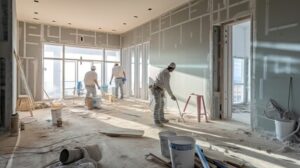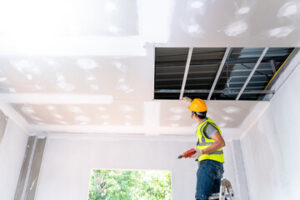It is important to consider their experience and expertise when choosing Las Vegas Drywall Contractors. This includes things like how long they have been in the business and what kind of projects they’ve worked on in the past.
It’s also important to ask about their insurance and licensing. It’s a good idea to interview several potential contractors before making a decision.

Do Your Research
When searching for a drywall contractor, you should do your research to find one who fits your needs and expectations. This means asking for recommendations from friends and family, as well as doing online research for reviews and ratings.
You should also ask potential contractors about their pricing, materials used, and experience. You must understand everything upfront so that there are no surprises down the road.
A good drywall contractor should also be willing to address any issues that arise after the project is finished. This shows that they care about their work and are committed to customer satisfaction. Investing the time to find a reliable and qualified drywall contractor will save you money and headaches in the long run. The results will be beautiful walls and ceilings that enhance your home or business.
Ask for References
When assessing potential drywall contractors, ask for references from past clients. These will provide an opportunity to speak directly with past customers and get an honest appraisal of the contractor’s work.
Be sure to also check out reviews of the contractor online, both on their website and third-party review sites. Look for reviews that emphasize quality work and a clear timeline for project completion.
Also, be sure to find out about the contractor’s licensing and insurance coverage. Doing this will ensure that you are working with an experienced and professional contractor. It will also protect you from any liability issues that may arise during the project.
Get an Estimate
When choosing a drywall contractor, it’s important to get an estimate for the project. Ask each contractor for a written quote that details all costs for materials and labor. Compare quotes carefully to see if there are any significant differences.
Also, make sure the drywall contractor is licensed and insured. Licensing requirements vary by location, so check your local regulations. Insurance is crucial because it protects you from liability in the event of an accident or damage during the project. Also, it’s a good idea to hire contractors who offer a warranty on their work. This gives you peace of mind knowing that your project is in good hands. Lastly, look for a contractor who communicates well. This will ensure that any questions or concerns are addressed promptly and efficiently. This will help keep the project on schedule and within budget.
Schedule an Interview
When interviewing potential drywall contractors, be sure to ask them about their company’s history and work. This is an excellent opportunity to assess their professionalism, expertise, and knowledge. Also, don’t forget to ask about their insurance coverage, bonding, and licensing.
Reputable drywall contractors should be able to provide references and reviews from previous clients. If they can’t, this should be a red flag. Also, be wary of a contractor who promises a timeline that seems too short. Drywall takes time to complete, so a contractor who rushes through the job is likely to give you low-quality results. Make sure to set up a walkthrough before starting the project and after it is finished to ensure that you are satisfied with the results. This will help avoid any future disputes or disagreements. Also, be sure to discuss payment terms and schedules.
Look for a Reputation
You want to be sure you’re hiring a contractor who has a solid reputation. Look for personal referrals from friends or family, as well as online reviews and forums.
A reputable contractor will have a portfolio of past work that they can show you. If they don’t, it’s a red flag.
In addition, you should ask to speak with previous clients so that you can find out about their experience working with the drywall contractor. Positive feedback regarding craftsmanship, timeliness, and professionalism are good indicators of a contractor’s overall quality of work.
You should also be sure to check whether the drywall contractor has workers’ compensation insurance. If they do, this is a sign that they are dependable and a trustworthy professional. It’s also important to ensure that the contract is clear and detailed about payments.
Look for Experience
If you’re looking for a contractor who will be capable of handling your specific project, it’s important to ask about their experience. The more experience they have, the more likely they are to be able to meet your needs and complete the job to your satisfaction.
You should also ask about the materials they use. Make sure they use high-quality products that will last and look beautiful for a long time. You may also want to ask if they have any special expertise, like soundproofing or painting, that will be beneficial for your project.
Additionally, make sure to ask about their work ethic and if they clean up after themselves. This is an important factor, as it will ensure that your home will be left as tidy as it was before the contractor began working.
Look for Insurance
In addition to licensing and experience, drywall contractors should carry appropriate insurance coverage. This includes general liability insurance, workers’ compensation insurance, commercial auto insurance, and equipment and tool coverage. This coverage protects clients from financial loss in the event of accidents or damage during a project.
Look for a contractor who offers pricing transparency and provides clear, detailed estimates for the project’s scope and costs. Inquire about their warranty and guarantee policy, as this demonstrates a commitment to quality workmanship.
Finally, it’s a good idea to read online reviews to gain a more holistic perspective of each contractor’s strengths and weaknesses. Doing your homework can help you find a reputable drywall contractor that will ensure a stress-free, high-quality construction project. You can also trust your instincts if something feels off. This is a sign that you should keep looking.
Look for a Contract
Whether you’ve received referrals from friends, searched online reviews, or found contractors on social media, it’s important to read their contracts carefully before making a decision. This will help ensure that the scope of work, payment schedules, materials to be used, warranties, and project timelines are clearly defined for both parties.
Evaluate the Contractor’s Communication Skills
Look for a drywall contractor who offers effective and timely responses to your questions. This will help to ensure that your renovation projects progress smoothly and are completed on time.
In addition, it’s also a good idea to ask the contractor about their experience with specialized projects like custom finishes and whether they have a dedicated team of employees or subcontractors. This can help to prevent any unexpected challenges that may arise during the project. Then, you can rest assured that your project will be completed to your satisfaction.
Drywall is a crucial part of any construction or renovation project, and you want to make sure the job is done properly. To avoid hiring a subpar contractor, take the time to do your research and choose an experienced professional. The right contractor will ensure that your drywall project is completed quickly, accurately, and to your satisfaction.
Start your search by asking for recommendations from friends, family, and coworkers. Personal referrals can provide valuable insights into a contractor’s work ethic, professionalism, and reliability. Once you have narrowed down your options, consider their licensing requirements, insurance policies, and customer reviews. By following these tips, you’ll be able to find the perfect contractor for your project. Best of all, you’ll know that your home renovation is in good hands from start to finish.
In a nutshell, you want a drywall contractor who genuinely cares about delivering superior results. This means being attentive to your preferences and needs, addressing any reservations promptly, and maintaining transparency throughout the process.
Expertise and Experience
A skilled drywall contractor is well-versed in the complexities of commercial drywall, including issues like soundproofing, insulation, and fire resistance. This understanding is essential to providing a high-quality finished product that meets the necessary safety and regulatory standards.
In addition, experienced contractors know the ins and outs of preparing drywall for painting or wallpapering. This includes properly securing the drywall, blending seams, and eliminating unsightly pop-out screws. This attention to detail is what separates a professional drywall contractor from a DIY amateur. The result is a flawless finish that will stand the test of time. For example, a pro will secure the drywall securely to the studs to avoid sagging over time and prevent cracks.
